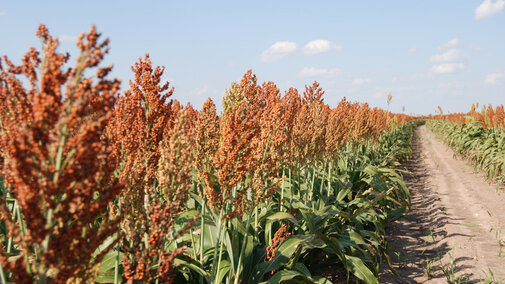Grain Sorghum Stover/Stalks Grazing
Grain sorghum stover compares favorably to corn regarding fall and winter stalks grazing, and livestock producers are encouraged to utilize corn and sorghum crop residues remaining after harvest. Both corn residue and sorghum stover can be good nutrition for mid- to late gestation cattle following fall grain harvest. Sorghum leaves have similar quality to corn husk and leaves; however, just like corn residue, the quality decreases over time.
Although both residue crops provide the highest nutrient content when grazed soon after grain harvest, it is highly recommended to prioritize grazing corn stalk fields first. Corn leaves tend to detach from stalks within one to two months after harvest and then blow out of stalk fields. This then dramatically lowers the nutrition remaining for grazing. In contrast, grain sorghum stover leaves remain attached to their stalks much longer into the winter and early spring; thus, retaining their grazing nutritional value longer.
Previous grain sorghum yields can be used to set optimum grazing stalking rates. For example, grazing rates might be one acre per cow per month for every 100 bushels of grain sorghum harvested this fall.
Unlike corn residue, grain sorghum stover has a threat of prussic acid toxicity immediately following a frost, since sorghum plants are often still green at harvest.
So, delaying grazing turnout until seven days after plant killing freezing temperatures will reduce prussic acid toxicity. Sorghum stover’s higher nutrient stem content may make it more prone to nitrate toxicity risk, especially on previously drought-stressed fields if the cattle are forced to graze the lower parts of the stems.
Sorghum stover usually has less lodging than corn residue, so mud and trampling field losses are generally less with sorghum during wet falls. Finally, spilled sorghum grain is likely safer than corn and not as likely to cause acidosis or founder as corn grain.
More crop residues research information is available on our CropWatch and UNL Beef websites.
Ammoniating Forages
By Brad Schick
With dry conditions across the state this summer, we may be low on forage reserves. Ammoniating low quality hay or crop residues may be a cheap way to stretch feed.
Ammoniation has been used for decades to improve the energy value or digestibility of low-digestibility forages. It also increases the crude protein (CP) content of the forage.
Overall, ammoniating corn residue increases the digestibility by about 10% units and the CP by about 5% units. Traditional corn residue bales that have been ammoniated are about 55% to 58% total digestible nutrients (TDN) and will have a CP content of 9% to 11%. Studies at Kansas State also show that dry matter intake can increase 22%.
How should we ammoniate bales? There are a few steps.
- Scrape an area of ground, leaving loose dirt to cover the edges of the plastic.
- Weigh the bales in order to know how much anhydrous ammonia should be added. It takes about 60 lbs. of anhydrous per ton of dry matter.
- Stack the bales in a three-bale or six-bale pyramid.
- Cover and seal the row of pyramids with silage plastic.
- Insert the pipe into the sealed bag. Make sure to have a shutoff valve on the pipe.
- Slowly release the anhydrous until the plastic has swelled.
- Shut off the valve and check the plastic for leaks.
- Add the remaining anhydrous at a rate of 8-10 minutes per ton of forage.
- Once completed, remove the pipe and seal up the hole.
It will take anywhere from one to eight weeks to complete the cycle depending on the air temperature. The warmer the temperatures are, the faster ammoniation will be.
Open one end of the stack three to five days prior to feeding to let the excess ammonia dissipate.
Ammoniating may be a cost-effective option for making low feed a higher quality feed.
Fall Pasture Management
While truly cold weather may still be a few weeks away, how we manage fall pastures can impact plant health through the winter and, ultimately, production next spring. Are you giving your pastures proper care this fall?
As temperatures cool, plants that overwinter are working on building up reserves before they become dormant. Cool season species like brome, wheatgrass, bluegrass and fescue will often produce a flush of fall growth if moisture is available. Since this flush stays in a vegetative state, quality can be high.
For plants that have been stressed by high temperatures and drought this summer, grazing now can actually deplete energy reserves going into the winter. This may result in decreased productivity and increased weed pressure next spring. Stockpiling this growth for use after the plant is dormant this winter may be a better option. This maximizes productivity this fall while still maintaining forage quality, albeit a bit lower than if grazed fresh.
For many of our native warm season species, their annual growth is wrapping up. While grazing these plants now won’t have as big of impact as actively growing cool season species, they too can be stressed by overgrazing in the fall. Pastures that are grazed in the fall this year should be given a break next year during critical growing periods in early summer, if possible, to rejuvenate plant vigor.
In mixed pasture where cool season species are invasive, there may be opportunity to control or reduce these gasses with grazing. Animals grazing these pastures will graze the new growth harder, with limited utilization of more mature warm season species. Keep a close eye on grazing progress and pull animals once the cool season species have been used and animals begin selecting warm season grasses. Follow this with more targeted cool season grazing next spring to weaken the unwanted plants and open the door for warm season grasses to fill in.

